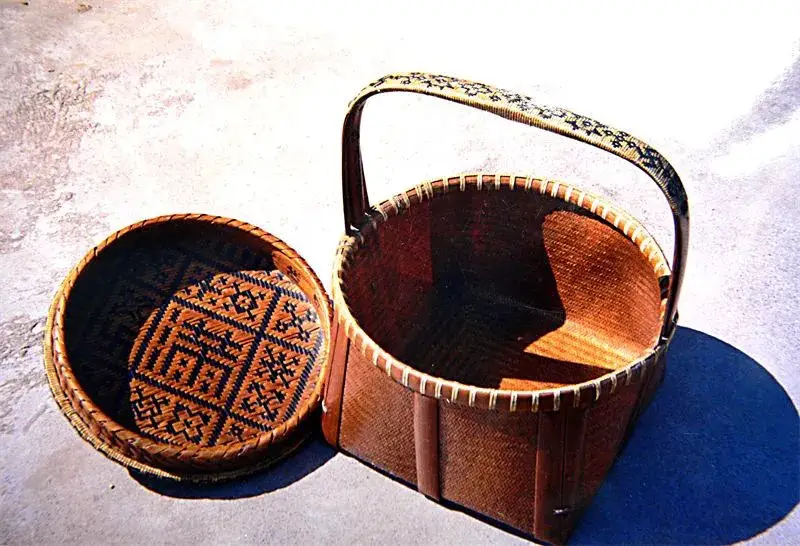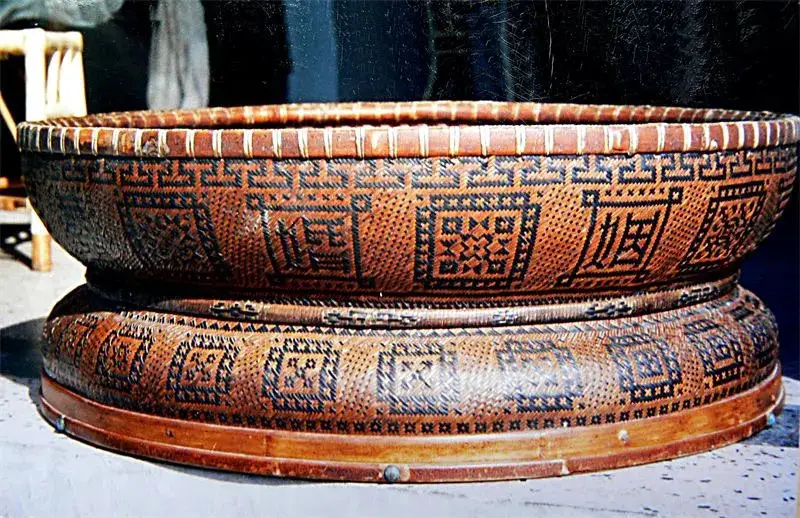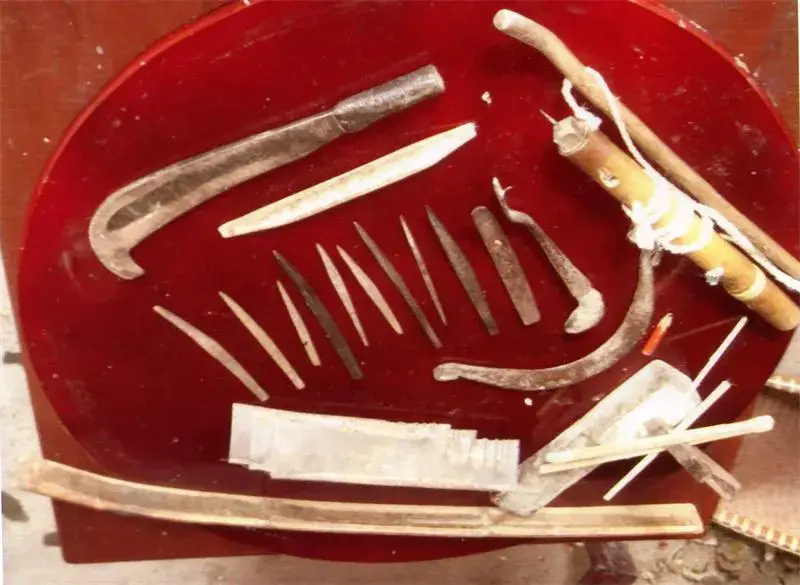Changhua bamboo weaving is a traditional handicraft with a long history, spanning over 2500 years, mainly distributed in the Changhua region of Zhejiang Province, especially widespread in the town of Qingliangfeng. This bamboo weaving technique has gradually become exquisite through the inheritance of generations of bamboo weaving artisans, evolving from initially producing primitive production tools to incorporating artistic elements, developing into artworks, daily necessities, gifts, and other bamboo weaving products.
The production process of Changhua bamboo weaving mainly consists of five steps: material selection, dyeing, weaving, copper buckling, and painting. It requires the use of various tools such as hand saws, bamboo knives, scrapers, flat drills, round chisels, bamboo rulers, and arrow gates. The crafts are mainly divided into two categories: fine silk crafts and coarse silk bamboo weaving crafts. Fine silk crafts are finely woven, focusing on shaping and color coordination, while coarse silk bamboo weaving crafts emphasize practicality and durability.
Changhua bamboo weaving is exquisitely crafted with rich local characteristics, representing the hard work of the local laborers. Its traditional representative works include fruit baskets, portraits of Mao Zedong and the Four Greats, Buddha statues, etc., while modern bamboo products mainly focus on household items. This type of bamboo weaving is not only practical but also highly ornamental, thus possessing high economic and cultural value.
In recent years, the inheritors of Changhua bamboo weaving have been continuously exploring and innovating, revitalizing this traditional handicraft with new vitality. They have not only innovated in craftsmanship but also made active efforts in product design and market expansion, gradually expanding the influence of Changhua bamboo weaving, attracting more attention and love.
Furthermore, Changhua bamboo weaving was included in the representative project list of intangible cultural heritage of Zhejiang Province in 2009. This not only acknowledges its historical and cultural value but also provides strong guarantee for the inheritance and development of Changhua bamboo weaving.
History of Changhua Bamboo Weaving
Changhua bamboo weaving has a long history dating back over 2500 years. Its origin is closely linked to the abundant bamboo resources and the livelihood needs of the local laboring people. The Changhua region is rich in bamboo, providing unique conditions for the development of bamboo weaving techniques. Through long-term practice, the people of Changhua gradually mastered the processing and weaving techniques of bamboo, creating distinctive bamboo weaving handicrafts.

Throughout history, the craft of Changhua bamboo weaving has continued to develop and improve. Initially, it was mainly used to make simple production tools such as bamboo baskets and bamboo sieves to meet agricultural production and daily life needs. Over time, bamboo weaving incorporated more artistic elements, evolving from simple utensils into valuable artworks.
In the process of inheritance, generations of bamboo weaving artisans played important roles. They not only mastered the bamboo weaving techniques but also continuously innovated and improved, allowing Changhua bamboo weaving to maintain its traditional characteristics while also meeting modern aesthetic and practical needs. Their efforts have made Changhua bamboo weaving a traditional handicraft with distinct local characteristics.
In modern times, Changhua bamboo weaving has gained international renown, with its products being exported to many countries and regions, receiving widespread praise and love. This not only showcases the unique charm of Changhua bamboo weaving but also reflects its profound cultural heritage and exquisite craftsmanship.
Heirs of Changhua Bamboo Weaving
Among the heirs of Changhua bamboo weaving, Jiang Anran is an outstanding representative. As the third-generation heir of Changhua bamboo weaving, he boldly innovated on traditional bamboo weaving techniques and achieved remarkable results. His works have won numerous awards, including the Bronze Award in the Hangzhou Folk Bamboo Crafts Competition, the Silver Award at the China (Zhejiang) Intangible Cultural Heritage Expo, and the Gold Award for Traditional Crafts in Lin’an, among others. In 2013, he was also named a folk artist of Lin’an City.
Jiang Anran is not only committed to inheriting and innovating bamboo weaving techniques but also actively participates in various handicraft experience activities and cultural exchanges, making significant contributions to the promotion and development of Changhua bamboo weaving. His efforts have brought Changhua bamboo weaving greater attention and recognition, injecting new vitality into this traditional handicraft.
In addition to Jiang Anran, there are other heirs silently contributing to the inheritance and development of Changhua bamboo weaving. Through continuous learning and practice, they pass on this craft from generation to generation, allowing more people to appreciate and experience the unique charm of Changhua bamboo weaving.
History and Cultural Inheritance of Lin’an Bamboo Weaving
Lin’an bamboo weaving, especially Changhua bamboo weaving, has a long history and profound cultural heritage. Its history can be traced back over 2500 years when laboring people began utilizing the abundant local bamboo resources to create various practical bamboo weaving tools and daily necessities. In the long process of development, bamboo weaving techniques gradually incorporated more artistic elements, evolving from simple production tools into exquisite artworks and household items.

In terms of cultural inheritance, Lin’an bamboo weaving mainly relies on a combination of oral transmission and practical operation. Through continuous practice and innovation, generations of bamboo weaving artisans have gradually enriched and expanded this craft. They not only mastered bamboo weaving techniques but also continuously integrated new creative ideas and elements, allowing Lin’an bamboo weaving to maintain its traditional characteristics while also meeting modern aesthetic and practical needs.
Furthermore, Lin’an bamboo weaving carries rich local characteristics and ethnic culture. In places like Qingliangfeng Town, bamboo weaving is not only common household items but also the crystallization of the laboring people’s hard work. Each bamboo weaving work contains abundant cultural connotations and unique artistic styles, showcasing the wisdom and creativity of the local people.
In recent years, the inheritance and development of Lin’an bamboo weaving have received extensive attention and support from the government and various sectors of society. Through various forms such as handicraft experience activities, cultural exchanges, and exhibitions, the cultural value and artistic charm of Lin’an bamboo weaving have been more widely disseminated and recognized. At the same time, some heirs have begun to integrate traditional bamboo weaving techniques with modern design concepts, creating more fashionable and practical bamboo weaving products, injecting new vitality into this traditional handicraft.
Historical Significance of Changhua Bamboo Weaving
The historical significance of Changhua bamboo weaving is manifested in several aspects:
Firstly, as part of China’s traditional handicrafts, Changhua bamboo weaving has a profound historical and cultural heritage. It carries rich historical and cultural information, reflecting the social outlook, aesthetic concepts, and craftsmanship of different periods. Through the study of Changhua bamboo weaving, one can gain a deeper understanding of the connotation and characteristics of traditional Chinese culture.

Secondly, Changhua bamboo weaving is the crystallization of the laboring people’s wisdom, embodying the creativity of folk artisans and the exquisite craftsmanship of manual labor. The inheritance and development of this traditional handicraft not only contribute to promoting the outstanding traditional culture of the Chinese nation but also inspire people’s national pride and cultural confidence.
Additionally, as a practical and artistic handicraft, Changhua bamboo weaving was once an indispensable part of people’s daily lives. It met people’s practical needs while also bringing aesthetic enjoyment. In modern society, although the practical value of Changhua bamboo weaving has gradually diminished, its unique artistic value and aesthetic significance are still loved and cherished by people.
Lastly, the inheritance and development of Changhua bamboo weaving also have important implications for promoting local economic development and cultural exchanges. By producing and selling bamboo weaving products, it can stimulate the production and sales of local bamboo and related raw materials, provide employment opportunities, and promote the development of the industry chain. At the same time, as a local cultural product with distinctive characteristics, Changhua bamboo weaving can also become an important carrier for cultural exchange and tourism promotion, driving the dissemination and development of local culture.
References:
1. “History of Changhua Bamboo Weaving” from the Cultural Museum of Hangzhou City.
2. “Significance of Bamboo Weaving Craft.”
3. “A Gem in the Mountains – Introduction to Changhua Bamboo Weaving.”
4. “Jiang Anran – Changhua Bamboo Weaving” from the Intangible Cultural Heritage Website of Hangzhou City.
5. “52-Year-Old ‘Uncle Bamboo Weaver’ Praised by CCTV” from Urban Express.